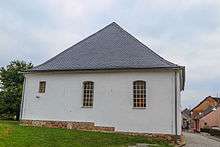Asriel Günzig
Asriel Günzig (also known as Azriel Günzig, Ezriel Günzig,[1][2] Israel Günzig,[1][3][4][5] Izrael Günzig,[6] or J. Günzig[7][8][9]) (Hebrew: עזריאל גינציג)[10] was a rabbi, scholar, bookseller, editor and writer.[1][3][4][11] He served as the rabbi of Loštice, Moravia, from 1899 until 1920.

Günzig was born on April 10, 1868, in Kraków, where he received traditional Talmudic education, and he finished his studies in philosophy and Semitic languages at the University of Bern,[1][4][11] where he earned his doctorate.[1][4]
In 1899,[1][3][4][11] he became the rabbi of the Jewish Congregation in Loštice, a position he held until the spring[1][4] of 1920, when he moved to Antwerp, Belgium,[1][3][4] with his family.[1][4]
In Antwerp, he became the head of the Hebrew[1] Tachkemoni School[3] and held this position for ten years.[1]
He died in Antwerp in 1931[1][3][4][11] at the age of 63.[1]
Family
Günzig and his wife Amalia (nee Schreiber) had four children: Regina (born 1898 in Kraków, died 1992), Sabine (born 1901 in Loštice; murdered at Auschwitz), Jacques (born 1904 in Loštice; murdered July 28, 1942, at the Mauthausen concentration camp) and Hilda (born 1910 in Loštice; died 1995).[1][3]
Works
His scholarly work was mainly focused on the history of Haskalah (Jewish Enlightenment) in Galicia, but he dealt with other subjects as well.[11]
In 1898, Günzig published Japheth ha-Levi's commentary on Ecclesiastes 1-3.[12][13]
His own published works include: Der Pessimismus im Judenthume (Kraków, 1899),[11][13] Rabbi Israel Baal-Schem (Brno, 1908);[7] Die "Wundermänner" im jüdischen Volke (Antwerp, 1921);[8][9] and Das jüdische Schrifttum über den Wert des Lebens (Hannover, 1924).[1][2][5]
In 1898-1913 he edited the literary magazine Ha-Eshkol[1] (Hebrew: האשכול).[10]
He also contributed to the Hebrew encyclopedia Ozar Yisrael.[10]
References
- "Rabín Dr. Asriel Günzig" [Rabbi Dr. Asriel Günzig] (in Czech). Retrieved Sep 24, 2017.
- "Das jüdische schrifttum über den wert des lebens". WorldCat. OCLC 5151431. Missing or empty
|url=(help) - Ginsberg, Johanna (Sep 21, 2011). "Czechs honor legacy of NJ man's grandfather". New Jersey Jewish News. Archived from the original on September 20, 2013. Retrieved Sep 28, 2017.
- Rybičková, Stanislava (Aug 29, 2011). "Loštickou synagogu otvírali hosté ze tří kontinentů" [Loštice Synagogue was opened by guests from three continents]. Šumperský a Jesenický Deník (in Czech). Vltava Labe Media. Retrieved Oct 18, 2017.
- "Das Jüdische Schrifttum Über den Wert des Lebens". PhilPapers. Retrieved Jan 17, 2018.
- "PhDr. Berthold Oppenheim" (in Czech). Dec 4, 2008. Retrieved June 18, 2017.
- J. Günzig (1908). Rabbi Israel Baal-Schem (in German). Brno: Jüdischer Buch- & Kunstverlag. Retrieved Sep 28, 2017.
- J. Günzig (1921). Die "Wundermänner" im jüdischen Volke (in German). Antwerp: Delplace, Koch & Co. Retrieved Jan 3, 2018.
- J. Günzig (1921). Die "Wundermänner" im jüdischen Volke (in German). Delplace, Koch & Co. Retrieved Jan 3, 2018.
- Eisenstein, J. D., ed. (1909). Ozar Yisrael אוצר ישראל (in Hebrew). 3. New York. Retrieved Aug 3, 2017.
- "The fates Lostice". respectandtolerance.com. 2010–2011. Retrieved Sep 24, 2017.
-

- Brann, M (1896). Geschichte der Juden und ihre Literatur (in German). Retrieved Oct 22, 2017.